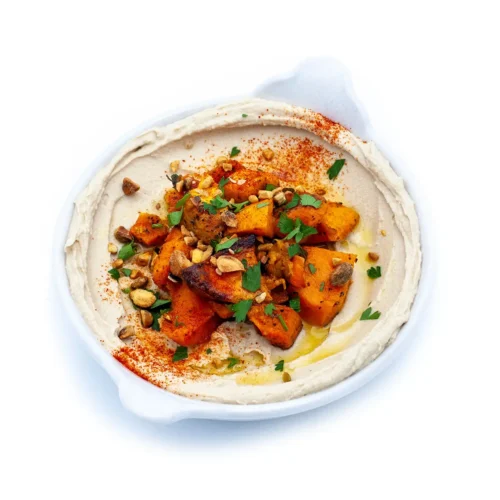
Hummus Tehina
No ratings yet
This hummus recipe blends nostalgia, local ingredients, and Middle Eastern tradition into one creamy, craveable dish. Using organic chickpeas and a rich tahini sauce, it's a love letter to the humble legume that deserves a starring role at any table.
Prep Time:15 minutes mins
Cook Time:1 hour hr 15 minutes mins
Overnight Soak:12 hours hrs
Course: Appetizer, Main Course, Side Dish
Cuisine: Mediterranean, Middle Eastern
Keyword: Chickpea, Tahini
Servings: 1 Quart
Calories: 1729kcal
Author: Rosminah Brown
Ingredients
- 1 cup chickpeas, dried, organic (Local sources include Jalama Valley’s garbanzo beans sold at Motley Crew Marketplace in Buellton, or the Baba booth at the Santa Barbara and Goleta farmers markets.)
- 2 teaspoons baking soda
Tahini Sauce
- 4 cloves garlic, peeled and lightly smashed
- ⅓ cup lemon juice, from 1-2 lemons, more to taste
- 1¾ teaspoons kosher salt, separated, more to taste
- 1 cup tahini, organic
- Water, cold
- ½ teaspoon cumin
Optional Toppings
- Olive oil
- Parsley, freshly chopped
- Lemon juice
- Sumac
- Smoked paprika
- Za'atar
- Pine nuts, toasted
- Vegetables, roasted, cut into bite-size pieces, such as butternut squash, carrots, beets
Instructions
- The night before, soak the chickpeas with 1 teaspoon of baking soda in a covered bowl.
- In the morning, drain and rinse the chickpeas, then place in a medium pot along with the second teaspoon of baking soda and cover with water, about 4 inches above the chickpeas.
- Bring to a boil, then turn down the heat to a low boil, cooking for up to an hour until the chickpeas are very soft. It’s OK to get them go mushy; this is the key to creamy hummus. Check the pot periodically to ensure the water doesn’t boil over or to top up with water if it gets too low.
- Meanwhile, prepare the tahini sauce: Place the smashed garlic and lemon juice in a blender or food processor, along with ¼ teaspoon of salt. Blend lightly to break up the garlic.
- Add the cup of tahini and blend. The tahini will quickly become a clumpy paste. Drizzle in the cold water, about ⅓ to ⅔ cup, a little at a time and continue blending until it forms a smooth, creamy and pourable sauce.
- Add the cumin and remaining salt, and blend. This tahini sauce is a base that can be used for a plethora of other recipes, but this batch will all go into the hummus.
- Once the chickpeas are boiled and very soft, lightly drain, retaining the drained liquid.
- Add the boiled chickpeas to the tahini sauce and turn the blender on full and let it go until completely smooth, adding the drained liquid back as needed. Note that while it’s hot, the hummus will appear more liquid and will firm up once it starts cooling.
- Taste the hummus and add more water and salt as needed; keep blending, 2 minutes or more. As long as your machine doesn’t overheat, you cannot overblend this—creaminess is key.
- To serve: Place a generous scoop in a shallow bowl and swirl your serving spoon through the hummus to create a crater. Drizzle in olive oil and lemon juice for a simple dish. Your hummus can also contain a variety of other toppings, like fresh chopped parsley, sprinkles of smoked paprika, sumac or your favorite za’atar. You can pile the center with roasted vegetables, braised meats, olives or any variety of Mediterranean salads for a more substantial meal.
Notes
Fresh warm hummus is special, you cannot get this in the store. Ideally, hummus is consumed within a couple hours of preparation, alongside warm bread like pita, or scooped up with whatever bread you love. For a less carb-filled meal, eat your hummus with vegetable crudités.
Then sit down with a friend and catch up over this humble seed, or bring it to a potluck meal and be prepared for recipe requests.
If not consumed immediately, store in the refrigerator. This will keep for 2–3 days.
Nutrition
Calories: 1729kcal | Carbohydrates: 107g | Protein: 58g | Fat: 132g | Saturated Fat: 18g | Polyunsaturated Fat: 58g | Monounsaturated Fat: 49g | Sodium: 6358mg | Potassium: 1729mg | Fiber: 24g | Sugar: 10g | Vitamin A: 224IU | Vitamin C: 48mg | Calcium: 457mg | Iron: 16mg